Why Suoyang City Ruins Should Be on Your Travel Itinerary
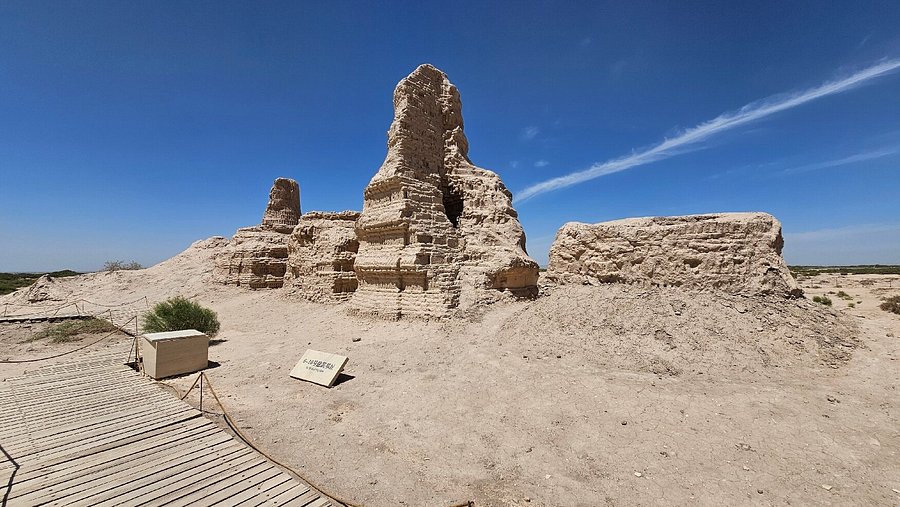
An Essential Guide to Visiting Suoyang City Ruins
Nestled amidst the undulating sands of the Gobi Desert, the Suoyang City Ruins—also known as Kuyu City—whisper tales of a bygone era when this ancient stronghold thrived as a vital hub along the storied Silk Road. Established during the Western Han Dynasty, this once-bustling city played a crucial role in safeguarding trade routes, fostering cultural exchanges, and serving as a sentinel against invasions.
Today, the remnants of Suoyang stand as a poignant reminder of human ingenuity and resilience in the face of nature’s harshest conditions. As you stroll along the well-preserved city walls, marvel at the scale of the structures, which echo the grandeur of the Tang Dynasty’s architectural style. The site is not just a relic; it is a canvas painted with the rich history of military strategy, economic prowess, and cultural heritage.
Visitors to the Suoyang City Ruins can experience the site through guided tours, which transport you to key locations such as the southwestern city walls and a magnificent temple complex. Although access is limited to certain areas to preserve the integrity of the ruins, each step you take within this ancient city stirs the imagination and invites reflection on the lives once lived here.
Whether you are a history buff, an archaeology enthusiast, or simply seeking a unique addition to your travel itinerary, the Suoyang City Ruins promise an enriching journey into the past, wrapped in the enchanting landscapes of Gansu Province. Prepare to be captivated by the stories etched in stone as you uncover the mysteries of this remarkable site.
In This Guide
- An Essential Guide to Visiting Suoyang City Ruins
- The Rich History and Legends of Suoyang City Ruins
- Main Highlights: What You Absolutely Can’t Miss
- Planning Your Visit: A Practical Guide
- Tickets: Prices, Booking, and Tips
- How to Get There: A Complete Transportation Guide
- Local Cuisine and Accommodation Nearby
- Frequently Asked Questions
- Final Thoughts on Your Trip
The Rich History and Legends of Suoyang City Ruins
Nestled in the arid expanse of the Gobi Desert, the Suoyang City Ruins, also known as Kuyu City, stand as a testament to the resilience and ingenuity of ancient civilizations. This remarkable site is located approximately 70 kilometers southeast of Anxi Town in Gansu Province, China, and played a pivotal role in the rich tapestry of the Silk Road.
The origins of Suoyang City date back to the Western Han Dynasty (206 BC – 9 AD), a period marked by significant territorial expansion and cultural exchange along the Silk Road. Established primarily to fend off invasions from the Huns, the city was strategically positioned to facilitate trade and secure the flow of goods between the East and the West. Its construction reflects the architectural prowess of the Tang Dynasty, featuring grand walls and intricate designs that showcase the city’s importance both politically and militarily.
As you explore the ruins, you will find remnants of an ancient military defense system and an advanced irrigation network, both of which highlight the city’s sophisticated infrastructure. The city walls, made from stamped clay, are a focal point of the site, towering over the landscape and providing a glimpse into the scale of this once-thriving urban center. Within the walls, archaeologists have uncovered a treasure trove of artifacts, including fragments of pottery, coins, and architectural remnants that date back to the Tang and Song Dynasties. These findings suggest that Suoyang was not just a fortress but a vibrant community that flourished over centuries.
One of the most striking features of the site is the large temple complex, which once housed a stunning pagoda and numerous stupas. Visitors can still see the impressive foundations and remnants of these structures, which serve as a reminder of the city’s religious significance in its heyday. The temple was not only a spiritual hub but also a center for trade and cultural exchange, attracting merchants and travelers from different regions.
The allure of Suoyang City extends beyond its physical remnants; it is steeped in local legends and folklore. Stories of brave warriors defending the city against foreign invaders and tales of merchants who traversed the Silk Road, laden with treasures, still resonate with the local populace. These narratives have been passed down through generations, adding a layer of mystique to the ruins that captivates the imagination of visitors.
Today, the Suoyang City Ruins are recognized as a UNESCO World Heritage site, a distinction that underscores their historical and cultural significance. While access to the ruins is limited to designated areas to preserve their integrity, the experience of standing atop the ancient walls and gazing over the vast desert landscape provides a profound connection to the past. Travelers can take guided tours that include visits to key points of interest, such as the southwestern city walls and the temple site, allowing for a deeper understanding of the city’s storied history.
For those journeying through Gansu Province, the Suoyang City Ruins are not merely a stop on the itinerary; they offer a glimpse into a bygone era where history, culture, and legend intertwine, inviting exploration and reflection in one of China’s most intriguing historical landscapes.
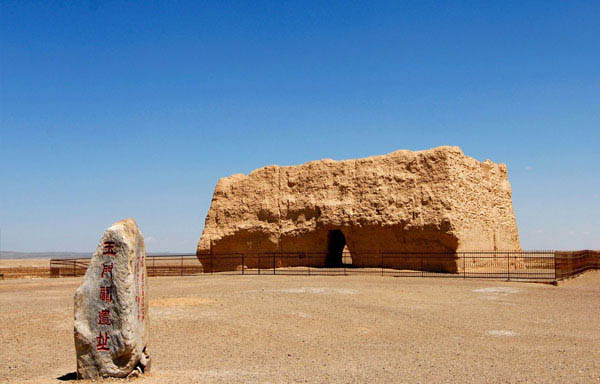
Suoyang City Ruins.
Main Highlights: What You Absolutely Can’t Miss
Exploring the Suoyang City Ruins is a journey back in time, immersing visitors in the rich history of this ancient Silk Road city. Here are the main highlights you absolutely can’t miss:
The Magnificent City Walls
The first sight that will leave you in awe are the massive walls encircling the ruins. Built during the Western Han Dynasty, these fortifications were designed to repel invasions and protect the Silk Road trade routes. Standing atop the walls, you can admire the impressive scale of the structure and imagine the strategic significance it held in its prime. It’s a remarkable experience that offers both a sense of history and breathtaking views of the surrounding Gobi Desert landscape.
The Temple Complex
Make sure to visit the temple site, which is one of the key focal points of the ruins. Here, you’ll find remnants of a grand temple complex, including a stunning pagoda and stupas that showcase the architectural prowess of the era. This area is not only visually striking but also steeped in spiritual significance, making it a peaceful spot for reflection amidst the historical remnants.
Guided Tours and Transportation
To access the ruins, you will need to partake in a guided tour, as private vehicles are not allowed within the site. You can choose between a horse cart ride or an electric buggy to traverse the key locations. This ensures a relaxed journey through the ruins while providing insights from knowledgeable guides who can share fascinating stories about the city’s past.
Archaeological Discoveries
As you explore, keep an eye out for ongoing archaeological work. The site is still being excavated, revealing artifacts that date back to the Tang Dynasty and beyond. From pottery shards to ancient coins, each find gives a glimpse into the daily lives of those who once inhabited this vital Silk Road hub.
Scenic Views of the Gobi Desert
Don’t forget to take a moment to appreciate the stunning desert scenery surrounding the ruins. The juxtaposition of the ancient walls against the vast, arid landscape creates a striking visual that is perfect for photography. The serene environment also offers a chance to reflect on the historical significance of this once-thriving city.
Historical Context
Before your visit, it’s beneficial to familiarize yourself with the history of Suoyang City. Understanding its role as a military and economic stronghold along the Silk Road enhances your appreciation of the ruins. This ancient city was not only a fortress but also a cultural melting pot, where traders from various regions converged, leaving behind a rich tapestry of influences.
Practical Tips
- Entrance Fee: As of July 2024, the entrance fee is 70 RMB for adults, with additional costs for transportation within the site.
- Timing Your Visit: The site is open 24 hours, but visiting during daylight hours is recommended for the best experience.
- Getting There: The ruins are located about 70 kilometers southeast of Anxi Town, making them an ideal stop on a road trip through Gansu Province.
Visiting Suoyang City Ruins offers a unique window into China’s ancient past, where history, architecture, and the stark beauty of the Gobi converge. Make sure this extraordinary site is on your itinerary when exploring the Silk Road!
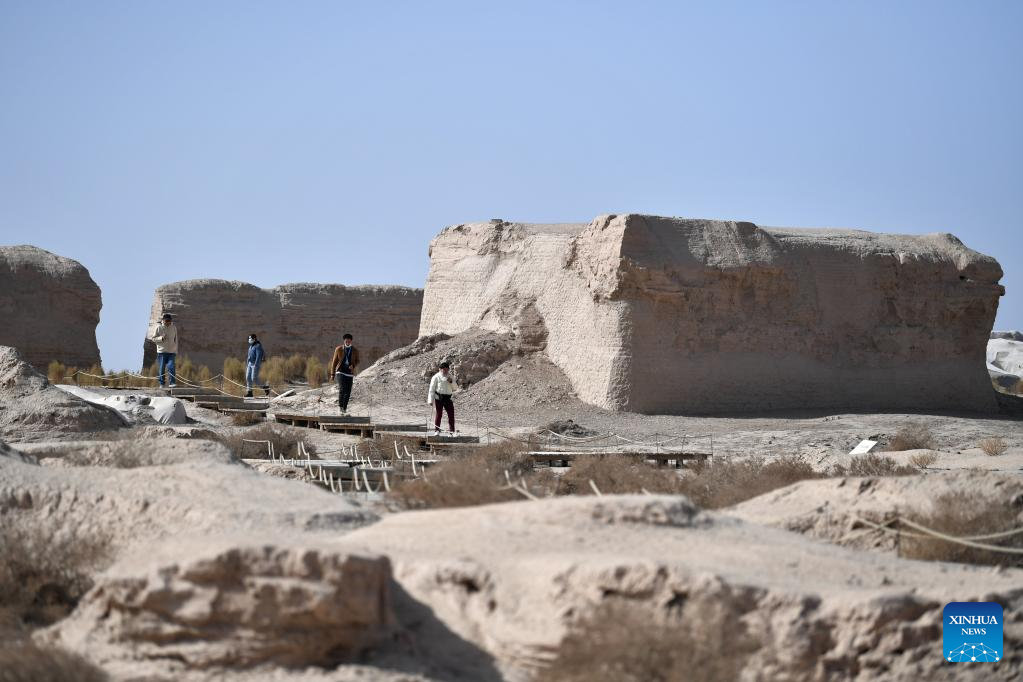
Suoyang City Ruins.
Planning Your Visit: A Practical Guide
Visiting Suoyang City Ruins offers travelers a unique glimpse into a pivotal point on the ancient Silk Road, rich with history and archaeological significance. Here’s everything you need to know to make the most of your visit:
Getting There
The Suoyang City Ruins are located in Guazhou County, approximately 170 kilometers southeast of the well-known tourist hub of Dunhuang. If you’re traveling from Dunhuang, consider renting a car or joining a guided tour, as public transport options may be limited. The site is easily accessible via the S239 highway, which is a scenic route worth exploring.
Entrance and Hours
The site is open 24 hours a day, making it convenient for those who wish to visit at sunrise or sunset for stunning views. As of July 2024, the entrance fee is 70 RMB for adults. Upon arrival, you will need to purchase a ticket at the tourist center located near the entrance.
Getting Around
Due to preservation efforts, visitors are required to take a guided tour vehicle to explore the ruins. You can choose between a horse cart ride for 100 RMB or an electric tour buggy car for 70 RMB. The tour will take you to two main locations: the southwestern city walls and the temple site, where you can disembark and explore a limited area. While you won’t be able to wander freely through the ruins, the designated spots offer impressive views and insights into the scale of this ancient city.
What to Expect
Suoyang City, also known as Kuyu City, was originally established during the Western Han Dynasty and prominently served as a military and economic hub. The ruins showcase remnants of a grand city wall, temple complexes, and traces of ancient irrigation systems. Look out for the large stupa and the mounds of ancient dwellings, which tell the story of continuous occupation through various dynasties, including the Tang and Song.
Tips for Your Visit
- Dress Appropriately: Given the site’s location in the Gobi Desert, wear comfortable shoes and dress in layers. The weather can be unpredictable, with stark temperature changes between day and night.
- Stay Hydrated: Bring plenty of water, as exploration can be taxing, especially during the warmer months.
- Photography: Don’t forget your camera! The ruins provide fantastic photo opportunities, especially from the viewing platforms.
- Combine Your Trip: Consider visiting nearby attractions such as the Yulin Grottoes and the Mogao Caves to enrich your experience of the region’s historical and cultural landscape.
Conclusion
A visit to Suoyang City Ruins is not just a journey into the past; it’s an adventure that deepens your understanding of ancient Chinese civilization and the Silk Road’s impact on trade and culture. Whether you’re a history buff, an archaeology enthusiast, or simply a curious traveler, this site is sure to leave a lasting impression. Enjoy your exploration of this remarkable piece of history!

Suoyang City Ruins.
Tickets: Prices, Booking, and Tips
When planning your visit to the Suoyang City Ruins, it’s essential to understand the ticketing process and pricing options available. The entrance ticket to this ancient site, which holds significant historical value along the Silk Road, currently costs 70 RMB per adult. This fee allows access to the scenic area, but keep in mind that visitors cannot drive or walk freely around the ruins.
Upon arrival, you will need to purchase your ticket at the nearby tourist center located just off the main road. Here, you can choose from a couple of transportation options to explore the ruins. For an additional 100 RMB, you can opt for a horse cart ride, or you may prefer the electric tour buggy, which is priced at 70 RMB. Both options will take you through the key sites, including the impressive southwestern city walls and a temple site, before letting you disembark to walk around select areas.
While the limitations on exploration might feel a bit restrictive, it’s important to appreciate that these measures are in place to help conserve the site’s integrity. The guided tour will provide you with a structured experience, allowing you to absorb the scale and history of Suoyang City without overwhelming the fragile ruins.
Tips for Your Visit:
- Timing: The site is open 24 hours a day, which means you can plan your visit around other activities or travel commitments. However, visiting during daylight hours is recommended to fully appreciate the views and take photographs.
- Travel Preparation: Given the site’s remote location in the Gobi Desert, ensure you bring water and snacks to stay refreshed during your visit.
- Combine Your Trip: Consider making a day of it by visiting other nearby attractions, such as the Yulin Grottoes or the historic forts along the S239 highway.
With these insights, you’re all set for an enriching journey to the Suoyang City Ruins, where history and the rugged beauty of Gansu province await!
How to Get There: A Complete Transportation Guide
Reaching the Suoyang City Ruins, a significant historical site nestled in the Gobi Desert of Gansu Province, is an adventure that blends the allure of ancient history with stunning desert landscapes. Here’s how you can get there effectively.
Getting to Suoyang City Ruins
By Air
The nearest major airport to the Suoyang City Ruins is Dunhuang Airport (DNH), located approximately 170 kilometers (about 105 miles) to the northwest. This airport receives flights from major cities like Beijing, Shanghai, and Xi’an. Upon arrival, you can rent a car or take a taxi to reach your destination.
By Train
For travelers preferring rail travel, the Dunhuang Railway Station is your best option. Trains from cities such as Lanzhou and Jiayuguan connect you to Dunhuang. From the station, you can hire a taxi or arrange for a local tour service to transport you to the ruins.
By Bus
Long-distance buses frequently travel from nearby cities, including Jiuquan and Zhangye, directly to Guazhou County. The bus ride provides a glimpse into the region’s scenic beauty, making for an enjoyable journey. Once in Guazhou, local transport options, including taxis, can take you to the Suoyang City Ruins.
Self-Driving
If you prefer to explore at your own pace, renting a car is a great option. The Suoyang City Ruins are accessible via S239 Highway. The well-maintained roads make the drive comfortable, and you can enjoy the beautiful Gobi Desert landscape along the way. Keep in mind that parking is available near the main entrance.
Entrance and Transportation Within the Site
Upon arriving at the Suoyang City Ruins, you will need to purchase an entrance ticket at the visitor center. As individual exploration of the site is restricted to protect its integrity, you have two options for getting around:
-
Horse Cart Ride: For a more traditional experience, consider taking a horse-drawn cart for approximately 100 RMB. This ride allows you to enjoy the scenery while comfortably traveling to key locations.
-
Electric Tour Buggy: A more modern alternative is the electric buggy, which costs around 70 RMB. This option is ideal for those looking for a quicker way to navigate the site.
Both modes of transport will take you to significant areas, including the southwestern city walls and a large temple complex, where you can get off to explore the ruins and soak in the historical ambiance.
Nearby Attractions
If you have time, combine your visit to the Suoyang City Ruins with other nearby attractions such as the Yulin Grottoes or the Dunhuang Mogao Caves. These sites are rich in history and art, enhancing your Silk Road adventure experience.
Practical Tips
- Timing Your Visit: The site is open 24 hours, but visiting during daylight hours is recommended to fully appreciate the ruins.
- Weather Preparedness: The Gobi Desert can have extreme temperatures, so dress in layers and carry water, especially during summer months.
With this guide, navigating your way to the Suoyang City Ruins will be a straightforward and enriching experience, allowing you to immerse yourself in the fascinating history of this remarkable site. Safe travels!
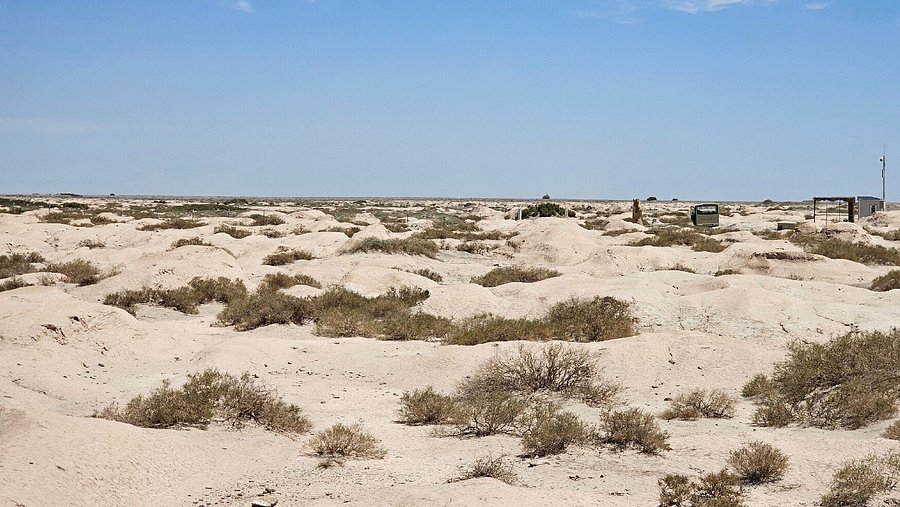
Suoyang City Ruins.
Local Cuisine and Accommodation Nearby
When exploring the remarkable Suoyang City Ruins, you’ll want to savor the local flavors and find comfortable accommodations nearby to enhance your experience. The region around Guazhou County offers a delightful mix of culinary delights and welcoming places to stay.
Culinary Delights
1. Guazhou Dazha Restaurant
Famous for its authentic Gansu cuisine, Guazhou Dazha offers a variety of local dishes that reflect the area’s rich culinary heritage. Don’t miss trying the Lanzhou beef noodles, a beloved staple known for its hand-pulled noodles and savory broth. For a unique taste, sample the Gansu-style dumplings filled with lamb and spices, which are a local favorite.
2. Xiangfeng Restaurant
Located just a short drive from the ruins, Xiangfeng Restaurant is another great spot to indulge in local flavors. The restaurant specializes in Xinjiang-style grilled lamb skewers, seasoned to perfection. Pair your meal with a refreshing milk tea, a popular beverage in the region that complements the spiciness of the food beautifully.
3. Shazhou Night Market
If you’re in the mood for a more casual dining experience, head to the Shazhou Night Market, which is vibrant with street food vendors. Here, you can try an assortment of snacks, such as spicy tofu, fried breadsticks, and sweet sticky rice balls. The market atmosphere makes for a lively evening, perfect for mingling with locals and tasting various dishes.
Comfortable Stays
1. Guazhou County Hotel
Just a short distance from the Suoyang City Ruins, the Guazhou County Hotel offers a comfortable stay with modern amenities. Guests appreciate its clean rooms and friendly staff, making it an ideal base for your explorations. The hotel also provides a restaurant featuring local dishes, allowing you to enjoy Gansu cuisine without stepping far.
2. Dunhuang Hotel
For those willing to venture a bit further, the Dunhuang Hotel provides a more upscale experience. This hotel combines traditional Chinese aesthetics with modern comforts and is located near major attractions such as the Mogao Caves. After a day of exploring, unwind in spacious rooms and enjoy the on-site dining options that showcase local flavors.
3. Guesthouses in Guazhou
For a more intimate experience, consider one of the local guesthouses. Many offer cozy accommodations with a personal touch, often run by families eager to share their culture. Staying in a guesthouse can also provide you with insider tips on the best local eateries and places to visit.
After a day spent wandering through the ancient ruins of Suoyang, you’ll find that the combination of local cuisine and comfortable accommodations will make your stay truly memorable. Whether you’re savoring a hearty meal or relaxing in a welcoming room, the essence of Gansu culture will surround you, enriching your travel experience.
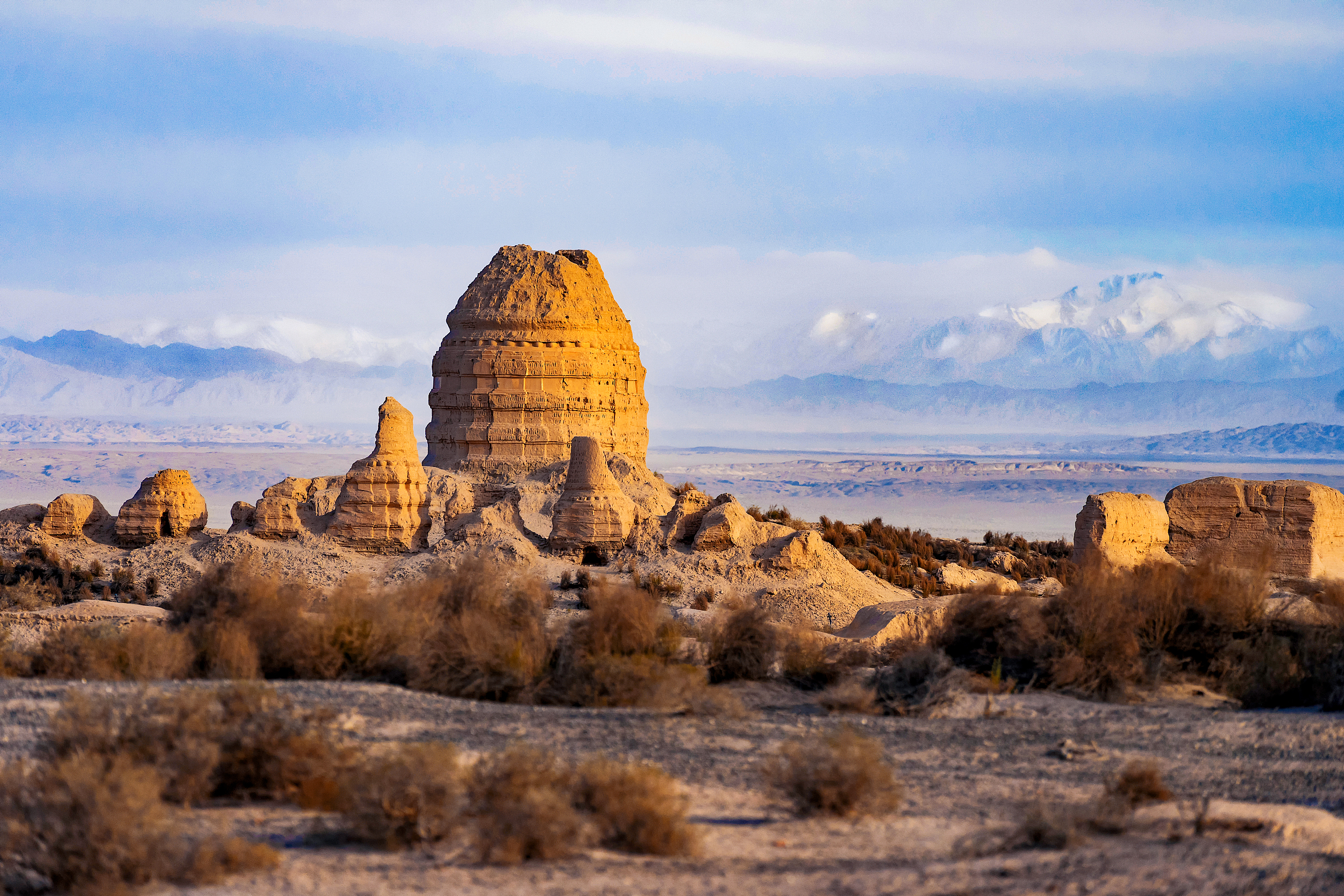
Suoyang City Ruins.
Frequently Asked Questions
Frequently Asked Questions about Suoyang City Ruins
-
What are the opening hours for Suoyang City Ruins?
Suoyang City Ruins are open 24 hours a day, allowing you to visit at any time that suits your travel schedule. -
Is there an entrance fee to visit the ruins?
Yes, there is an entrance fee of 70 RMB per adult for access to the ruins. Additional costs apply if you choose to take a horse cart ride (100 RMB) or an electric tour buggy (70 RMB) around the site. -
Can I explore the entire area on foot?
Unfortunately, visitors cannot freely walk throughout the entire site. You will be transported by a tour vehicle to designated spots, primarily the south-western city walls and a temple site, where you can get off to walk around. -
What historical significance do the Suoyang City Ruins hold?
Suoyang City was a vital stop on the ancient Silk Road, established during the Western Han Dynasty. It played a crucial role in trade, defense, and cultural exchange, showcasing the rich history of the region. -
Are there facilities available for tourists?
Yes, there is a tourist center located near the entrance where you can purchase tickets and obtain information about the site. However, amenities like restrooms may be limited, so plan accordingly. -
What should I wear or bring for my visit?
Given the site’s location in the Gobi Desert, it’s important to dress in layers and wear comfortable walking shoes. Don’t forget to bring water, sunscreen, and a hat to protect yourself from the sun. -
Can I visit other attractions nearby?
Absolutely! Suoyang City Ruins are located near other significant sites, such as the Yulin Grottoes and the Mogao Caves. Consider planning a day trip to explore multiple historical attractions in the area. -
Is the site accessible for people with disabilities?
The site has limited accessibility due to its ancient structure and the nature of the terrain. If you have mobility concerns, it’s advisable to check in advance regarding specific accommodations or consult with your tour provider for assistance.
Final Thoughts on Your Trip
As you reflect on your journey through the Suoyang City Ruins, allow yourself to be captivated by the echoes of history that linger in the air. This ancient fort city, once a thriving hub on the Silk Road, invites you to ponder the resilience and ingenuity of those who built it amidst the vast Gobi Desert. Standing atop the impressive walls, you can almost envision the bustling marketplace and the vibrant exchanges that once took place here.
Though access to the site is limited for preservation, the carefully curated experiences allow you to appreciate the grandeur of the ruins and the significance of their legacy. The remnants of the grand temple complex and the sturdy fortifications serve as a testament to a civilization that thrived against the odds. Each step you take along these ancient pathways is a connection to the past, a reminder of the stories that shaped this land.
Whether you are a history enthusiast or simply seeking a unique adventure off the beaten path, the Suoyang City Ruins offer a profound sense of discovery. As you continue your travels through Gansu, carry with you the spirit of exploration and the appreciation of the rich tapestry of cultures that have woven the Silk Road into the fabric of our world. Embrace the journey, for it is in these remote corners that the heart of history beats strongest.